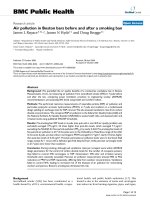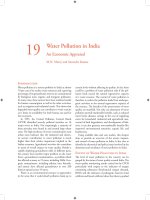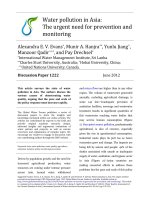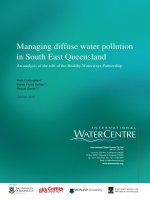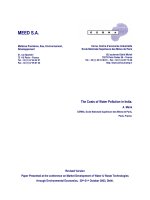mitigating water pollution in vietnamese aquaculture production and processing industry the case of pangasius and shrimp
Bạn đang xem bản rút gọn của tài liệu. Xem và tải ngay bản đầy đủ của tài liệu tại đây (1.87 MB, 215 trang )
i
Mitigating water pollution in Vietnamese aquaculture
production and processing industry
The case of pangasius and shrimp
Pham Thi Anh
ii
Thesis committee
Thesis supervisors
Prof. dr. ir. A.P.J. Mol
Professor of Environmental Policy, Wageningen University
Prof. dr. C. Kroeze
Personal chair at the Environmental Systems Analysis Group, Wageningen University
Thesis co-supervisor
Dr. S.R. Bush
Assistant professor, Environmental Policy Group, Wageningen University
Other members
Prof. dr. J.A.J. Verreth, Wageningen University
Prof. dr. L. Hordijk, the Joint research Center of the European Commission (IES-JRC),
Italy
Dr. J.M. Bavinck, University of Amsterdam
Dr. Nguyen Trung Viet, Van Lang University, Vietnam
This research was conducted under the auspices of SENSE - Research school for Socio-
Economic and Natural Sciences of the Environment
iii
Mitigating water pollution in Vietnamese aquaculture
production and processing industry
The case of pangasius and shrimp
Pham Thi Anh
Thesis
Submitted in fulfillment of the requirements for the degree of doctor
at Wageningen University
by the authority of the Rector Magnificus
Prof. dr. M.J. Kropff
in the presence of the
Thesis Committee appointed by the Academic Board
to be defended in public
on Wednesday 27
th
October 2010
at 4 p.m. in the Aula
iv
Pham Thi Anh
Mitigating water pollution in Vietnamese aquaculture production and processing
industry: the case of pangasius and shrimp
PhD- Thesis Wageningen University, with summary in English, Dutch and
Vietnamese
ISBN 978-90-8585-772-3
v
Acknowledgement
With great support from Prof Arthur Mol, Prof Leen Hordijk and Dr Nguyen Trung
Viet, I was accepted as a sandwich PhD student of Wageningen University at the end of
2001. I would first like to thank them for their help in making my PhD possible.
From the start to the completion of this book a long time has passed during which I
gained many experiences in work, relationships and life. I am very grateful for the help
of many people during this long period. I greatly appreciate the valuable advice,
guidance and encouragement from the supervisors’ team: Prof Arthur Mol – Chair of
Environmental Policy group, Prof Carolien Kroeze – Environmental System Analysis
group, and Dr Simon Bush – Environmental Policy group. Without their critical and
detailed comments on design, analysis and writing, this dissertation would not have
been what it has now become. There are no words to entirely express my gratitude to all
what my promoter and supervisors have done to enrich my knowledge and teach me
how to conduct a scientific research. I would like to give some special sentences to Prof
Carolien Kroeze. She always gave important support not only for my thesis work, but
also to keep a positive attitude during difficult episodes. Carolien, I learned from you
not only the way to do a PhD, but also the way to become a good teacher, a good
supervisor, and a good co-operator. I would like to thank to Marcel, Tomas and Robin
for their kindness to receive me to work with you at your home. I wish you all have
much happiness and success together forever. I also would like to write special words of
gratefulness to Simon for his supervision, from whom I learned to be critical in my
scientific work. I also would like to thank Catja for her friendship.
I would like to express my gratefulness to Dr Nguyen Trung Viet, Head of the
Department of Environmental Technology and Management – Van Lang University,
who always actively and generously thinks and works with his staff and students. I
remember the sentence he said to me when I decided to go to the Netherlands for my
MSc in 1997: “Tell me when you meet any difficulty”. It is a short sentence, but it had a
large effect on my work and he always repeated it when I was doing something
important – including my PhD study in the Netherlands.
My acknowledgement also goes to the sources of my financial support without which I
could not have finished this thesis. My travelling, study and time spent in the
Netherlands came from the budget of the REFINE project, which was funded by the
Ministry of Foreign Affairs of The Netherlands. The funding for the study on shrimp
farming in the Can Gio area came from CENTEMA. During the last period, the work on
Pangasius projects was financially supported by SMARTCHOICE Company.
I would like to thank the rector of Van Lang University, Dr Nguyen Dung, for his
support to my work at the University and his encouragement to my studies.
vi
I would like to thank the colleagues of Van Lang University, who encouraged me a lot
during my teaching and work. I love Van Lang University.
I highly appreciate my Vietnamese colleagues and the students of the Department of
Environmental Technology and Management, among them Huynh Ngoc Phuong Mai,
Tran Thi My Dieu and Le Thi Kim Oanh, who share with me the day to day the efforts
of teaching, research and carrying out projects. Our long cooperation and friendship for
life is unforgettable. The same is true for the collaboration with other good colleagues
who have worked with me for a long time: Nguyen Kim Thanh, Nguyen Thi Phuong
Loan, Ly Khanh Tam Thao, Pham Hai Yen, Truong Mong Diem and Ho Phung Ngoc
Thao. I would like to thank Hoang Quoc Hung and Nguyen Xuan Dong for helping me
in assistant and design the thesis’s cover.
I also would like to thank the students and colleagues who work with me in the field of
shrimp and pangasius at CENTEMA and SMARTCHOICE: Bich Thuy, Xuan Tuong,
Ngoc Anh, Thanh Binh, Thuy Van, Minh Trang, Ha Minh.
It has always been pleasant to work with the Environmental Policy Group and
Environmental Systems Analysis group of Wageningen University. I owe many thanks
to Prof Kris Van Koppen, Dr Peter Oosterveer, Prof Gert Spaargaren, Loes Maas, Dr
Bas van Vliet, Astrid Hendriksen, Dr Judith van Leeuwen, Elisabeth, for their
interesting lectures, and for being good colleagues and friends during my stays in the
Netherlands. Special thanks go to Corry Rothuizen and Ria Cuperus for their
helpfulness during my work at both departments.
Many friends who have shared with me joys and sadness during my work in Vietnam
and studies in Wageningen are acknowledged, among them Phuong Khanh and Frank
Dumoulin, Ke and Quyen, Mathilde Kupper, Pham Hong Nhat, Phan Thu Nga, Le Van
Khoa, Bui Thi Lan Huong, Lai Thi Lan Huong, Minh Dieu, Phung Ha, Thu Ha, Alexi,
Kim Dung, Minh Thu,
I would like to mention in particular the Willems’ family: Joop and Lise, Edward,
Germa, Ellen and Marcel and their children. With them I feel I also have a family in the
Netherlands.
I would like to thank to Joost van Buuren. He helped me a lot at the beginning of my
MSc study, and became a member of my family. Brother Pham Dinh Giot, you shared
with us many things, in the Netherlands and Vietnam. I am happy to know you and your
family: Aja and Jan Oudendijk and their children, and Anneke van Buuren and Rens
Ijland. They all make me feel a close and beloved friend.
I am proud to be a daughter of my parents Pham Thong and Huynh Thi Them, and to be
a sister of my brothers and sisters, Than, Huong, Thai, Hoa, Chau, Phu, Dinh, Dam,
Tam and their husbands, wives and children. I would like to thank to all of them for
their love, care and encouragement. All their names cannot be listed here, but I
vii
remember them all. I dedicated this work to my parents in law for their wishes to my
work and cares to my family.
Finally, it is my pleasure to express special thanks to my beloved husband, Nguyen
Quang Hop, for his love and responsibility to me and the children. Since I married him,
I feel more confident and my work has become more efficient. To my son, Quoc Phap
and daughter, Hoang Ngan, I would like to say that you are the source of all the energy I
have needed to push me to complete this work. I dedicate this work to you all.
HCMC/Wageningen, June 2010
viii
ix
Table of contents
Acknowledgement v
Table of contents ix
List of tables xiii
List of boxes xv
List of figures xvii
Abbreviations xxi
Chapter 1 Introduction 1
1.1 The Vietnamese fishery sector 1
1.2 The environmental impacts of aquaculture production in Vietnam 6
1.3 Environmental management of aquaculture production in Vietnam 8
1.4 Research objectives 10
1.5 Research methodology 10
1.6 Structure of thesis 16
Chapter 2 Water pollution by pangasius production in the Mekong
delta – Vietnam: causes and options for control 21
2.1 Introduction 21
2.2 Materials and methods 25
2.3 Results: Pangasius farming 26
2.4 Results: Pangasius frozen fillet processing 44
2.5 Discussion and conclusions 53
Chapter 3 Water pollution by intensive brackish shrimp farming in
South-East Vietnam: causes and options for control 55
3.1 Introduction 55
3.2 Material and methods 58
x
3.3 The shrimp farming system 60
3.4 Environmental impact of intensive black tiger shrimp farming 65
3.5 Options to reduce the environmental impact 72
3.6 Conclusions 78
Chapter 4 Towards eco-agro industrial clusters in aquatic
production: the case of shrimp processing industry in
Vietnam 81
4.1 Introduction 81
4.2 Shrimp production chains and material balances of frozen shrimp
processing 84
4.3 Options in constructing an eco-agro-industrial cluster for shrimp
processing industry 93
4.4 Designing a frozen shrimp eco-agro-industrial cluster in Soc Trang
province 96
4.5 The governance of eco-agro industrial cluster of shrimp in Soc
Trang provinve: Actors and institutions 98
4.6 Conclusions 103
Chapter 5 Multi-level environmental governance in Vietnam: Water
pollution reduction in pangasius and shrimp aquaculture 105
5.1 Introduction 105
5.2 Multi-level governance of place-based aquaculture 107
5.3 Methodology 108
5.4 International governance through the WWF aquaculture dialogues 109
5.5 National governance 115
5.6 Community-based governance 119
5.7 Discussion and conclusions 123
Chapter 6 Discussion and conclusions 125
6.1 Introduction 125
6.2 Main findings 125
6.3 Comparing shrimp and pangasius 128
6.4 Methodological issues 134
xi
6.5 Strengths and limitations of the study 137
6.6 Recommendations 140
References 145
Summary 169
Samenvating 175
Tóm tắt 181
SENSE Certificate 187
About the author 191
Funding 183
xii
xiii
List of tables
Table 2.1 Indicators for water pollution by pangasius farming, as used in
this study.
31
Table 2.2 Selected characteristics of the wastewater in pangasius
farming (wastewater), compared with Vietnamese standards
for surface water quality (TCVN 5942 - 1995).
32
Table 2.3 Pollution caused by pangasius farming in the Mekong Delta 35
Table 2.4 Options for the reduction of water pollution by pangasius
farming in the Mekong Delta
42
Table 2.5
Indicators for the environmental pressures caused by
pangasius processing
47
Table 2.6 Composition of wastewater from pangasius processing
factories
49
Table 2.7 Pollution caused by processing of pangasius to frozen fillets in
the Mekong Delta
51
Table 3.1 Comparison of the general characteristics of brackish shrimp
farming systems in Vietnam
56
Table 3.2 Recommended water quality for black tiger shrimp farming 61
Table 3.3 Indicators for environmental pressures caused by shrimp
production in Can Gio
65
Table 3.4 Characteristics of wastewater from intensive black tiger
shrimp ponds in Can Gio
68
Table 3.5 Pollution caused by black tiger intensive shrimp farming in
Can Gio district
71
Table 3.6 Comparison of intensive shrimp farming in Vietnam (Can
Gio) and Thailand
72
Table 3.7 Waste prevention and minimization at source 73
Table 3.8 Treatment and reuse of effluent streams 76
xiv
Table 4.1 The wastewater characteristic of shrimp processing industry 91
Table 5.1 Proposed technical options for reduction of water pollution at
farm level related to PAD and ShAD standards.
112
Tablẹ.5.2 Public comments (1st and 2nd round) in general and on
specific issues (2,3,5 and 6) of PAD.
113
Table 5.3 Cooperatives in agricultural sectors in Vietnam (2008) 120
Table 6.1 Comparing pangasius and black tiger shrimp farming systems 128
xv
List of boxes
Box 2.1 Typical characteristics of a pangasius farming pond of 1
hectare
32
xvi
xvii
List of figures
Figure 1.1 Relative share in export turnover value of different agricultural
products in total export turnover from Vietnam
3
Figure 1.2 Vietnamese fishery production 4
Figure 1.3 Relative share of different countries in pangasius production (in
tons)
4
Figure 1.4 Relative share of different countries in shrimp production (in
tons)
5
Figure 1.5 Overview of Vietnamese fisheries and related environmental
consequences
5
Figure 1.6 Causes, effects and possible solutions of environmental
problems due to aquaculture and fish processing industry
8
Figure 1.7 Research framework 11
Figure 1.8 Five step approach to analyze technical and management
options to increase the sustainability of aquaculture production
in Vietnam.
15
Figure 2.1 Pangasius production in the Mekong delta by farming type 22
Figure 2.2 Schematic overview of the pangasius production, including 2
systems: The pangasius grow-out farming and pangasius frozen
fillet processing system.
26
Figure 2.3 Schematic overview of pangasius production in ponds 29
Figure 2.4 Schematic overview of pangasius farming and its
environmental impacts.
31
Figure 2.5 Water pollution by pangasius farming. Units: kg per ton of
fresh pangasius fish.
36
Figure 2.6 Options to reduction water pollution by pangasius farming 37
Figure 2.7 Processing of fresh pangasius into frozen fillets (as block or
individual)
45
xviii
Figure 2.8 Schematic overview of pangasius frozen fillet production and
its environmental impact
46
Figure 2.9 Water balance for the processing of one ton of pangasius fresh
fish
48
Figure 2.10 Water pollution by the production of frozen pangasius fillet.
The graph shows pollution from ponds and processing. Units:
kg pollutant per ton of fillet
51
Figure 3.1 Area and production of shrimp farming in Vietnam in 1999 –
2008
57
Figure 3.2 Schematic overview of Shrimp production in Can Gio area and
its environmental impact
64
Figure 3.3 Overview of water supply and discharge in ponds over time 66
Figure 4.1 Current location of the Shrimp processing industries in Soc
Trang province
85
Figure 4.2 Schematic overview of frozen shrimp processing as typically
applied in Vietnam
86
Figure 4. 3 Solid material balances in processing one ton of shrimp. 89
Figure 4.4 Water balance for the processing one ton of shrimp material 90
Figure 4.5 Material and energy balance for shrimp processing in Soc
Trang province
92
Figure 4.6 Design of an eco-agro industrial cluster for shrimp processing
in Soc Trang province
97
Figure 4.7 Networks embedding shrimp processing industry in Soc Trang
province (main relations for eco-industrial clusters in bold
lines)
98
Figure 5.1 Provincial pangasius production in Vietnam 106
Figure 6.1 Water pollution by pangasius farming and intensive black tiger
shrimp farming (excluding sludge) (kg/ha).
129
Figure 6.2 Water pollution by pangasius farming and intensive black tiger
shrimp farming (excluding sludge) (kg/ton).
130
xix
Figure 6.3 Water pollution by pangasius farming and intensive black tiger
shrimp farming (excluding sludge) (kg/USD)
130
Figure 6.4 The five step approach in this thesis and possible iterations 137
Figure 6.5 Research frameworks 139
Figure 6.6 Proposed a combination of system analysis, technology
assessment and governance analysis for increasing
sustainability of fish production in the Mekong delta of
Vietnam.
143
xx
xxi
Abbreviations
AFA An Giang Fisheries Association
AGRIFISH An Giang Fisheries Import Export Joint Stock Company
AGU An Giang Unviersity
APFIC Asia-Pacific fishery Commission
APHA American Public Health Association
APPU An Giang Pure Pangasius Union
BATs Best Available Technologies
BMP Best Management Practices
BOD Biochemical Oxygen Demand
BQF Block Quick Frozen
CDM Clean Development Mechanism
CENTEMA Center for Environmental Technology and Management
CERs Certified Emission Reductions
CoC Code of Conduct for Responsible Fisheries
COD Chemical Oxygen Demand
CoP Code of Practice
DARD Department of Agriculture and Rural Development of province
DO Dissolved Oxygen
DONRE Department of Natural Resource and Environment
eFCR Economic Feed Conversion Ratio
EPA Environmental Protection Agency
ESA Environmental System Analysis
FAO Food and Agriculture Organization
FCR Feed Conversion Ratio
FFER Fish Feed Equivalence Ratio
GAP Good Aquaculture Practices
GDP Gross Domestic Product
GSC Global Steering Committee
HACCP Hazard Analysis and Critical Control Points
HCMC Ho Chi Minh City
IE Industrial Ecology
IPCC Intergovernmental Panel on Climate Change
IQF Individual Quick Frozen
ISO International Organization for Standard
MARD Ministry of Agriculture and Rural Development
MOFI Ministry of Fishery
MONRE Ministry of Natural Resource and Environment
MRC Mekong River Commission
NACA Network of Aquaculture Centres in Asia-Pacific
xxii
NAVIQAVED National Fisheries Quality Assurance and Veterinary Directorate
N-NH
3
Nitrogen ammonia
PAD Pangasius Aquaculture Dialogue
PFG Process Facilitation Group
QCVN National Technical Regulation of Vietnam
RIA 2 Research Institute for Aquaculture in Vietnam, No. 2
RSCs Regional Steering Committees
ShAD Shrimp Aquaculture Dialogue
SUDA Sustainable Development of Aquaculture
SUMA Support of Brackish Water and Marine Aquaculture
TAD Tilapia Aquaculture Dialogue
TCVN Vietnamese standards
TN Total Nitrogen
TP Total Phosphorus
TSS Total Suspended Solid
TWG Technical Working Group
UNDP United Nation Development Program
UNEP United Nation Environmental Program
UNESCO United Nations Educational, Scientific and Cultural Organization
VLU Van Lang University
VNCPC Cleaner Production Center of Vietnam
WB World Bank
WWF World Widelife Fund for Nature
1
Chapter 1 Introduction
1.1 The Vietnamese fishery sector
Fishery is one of the most dynamic food sectors in the world, with total production
having grown to 110 million tonnes in 2006. Seafood is now the most globally traded
product by value and volume (FAO 2009b). Coastal states around the world have
striven to take advantage of this growing international demand by investing in modern
fishing fleets and processing factories. In recent years, attention has been given to the
stabilization or even possible decline (Watson and Pauly 2001) of capture fisheries
production. The FAO now classifies 52% of fish stocks as fully exploited and 28% as
over exploited fish stocks (FAO 2009b). The continued growth in fish production is
now largely the result of the increased production of aquaculture - which has now
emerged as the fastest growing production system in the world (FAO 2007c), (2009b).
In Vietnam the fishery sector is a significant and fast growing component of the
Vietnamese economy. Starting with the market reforms of 1986 under Doi Moi (or
‘renovation’) the Vietnamese fishery sector has developed rapidly in terms of both
production and exports. The largest dramatic growth occurred between 1997 to 2007
during which time total fish production increased 165%, from 1,570 million tons to
4,160 million tons (Dung 2008). It is now the fourth most important export sector to the
national economy, after oil, garments and footwear, and the most important sector in
terms of primary production (Figure 1.1). In 2007 fish and fish products make up
approximately 4% of GDP, and contribute 8% to total export value and 10% to total
employment (Dung 2008).
Similar to world production the growth of Vietnamese fishery production has been
maintained predominantly through the expansion of aquaculture. As shown in Figure
1.2, capture fisheries have grown at around 7% per year in the last decade while
aquaculture has grown at 16.3%. In real terms aquaculture production has grown from
481 million tons in 1997 to 2 billion tons in 2007 (Dung 2008). This production
includes a wide range of species grown in freshwater, brackish and coastal waters.
Between 2002 and 2004 Vietnam was the third country of the world in term of
aquaculture growth (FAO 2007c), and from 2006 Vietnam ranks third in terms of
quantity of aquaculture production (FAO 2009b). In 2007 Vietnam exported over 900
kton of fish products, which increased to 1,200 kton in 2008 (MARD 2009a).
Vietnamese fish products are currently exported to over 128 countries, but 69% is
traded to Europe, Japan, Russia and the US(MARD 2008b).
Among various aquaculture species which are being raised in Vietnam, two have the
largest contribution to production and export value: the freshwater striped catfish,
Pangasius hypopthalmus (Ca Tra in Vietnamese), and the brackish water black tiger
2
shrimp, Penaeus Monodon (Tom Su in Vietnamese). These two species alone account
for approximately 50 percent of the total production volume of aquaculture in Vietnam
(Trong 2008) and 68% of export value (MARD 2009b). Both species can be considered
what Hall (2003) has labeled ‘boom crops’ given the spectacular increases in
production, the relative accessibility of production for some segments of the rural
communities looking to ‘get rich quick’, as well as the parallel growth of both local and
global political, environmental and economic uncertainties and vulnerabilities. In
particular, both species have also come under increased scrutiny over their
environmental performance as production and processing has expanded in a largely
uncoordinated fashion.
The rise of pangasius has been particularly spectacular with total production having
grown at around 30% per year since 2003. Due to low investment costs, high
productivity and large export markets, pangasius cultivation has become a popular form
of aquaculture and the largest single species farming system by volume in Vietnam
(Phan et al. 2009). Over the last 10 years, pangasius has developed from a domestic to
an export product. In 2007 the productivity of pangasius reached over 1 million
tons/year, a government target previously set for 2010 (Bush et al. 2009), and is now
exported to nearly 110 countries and territories mainly as frozen fillet products. The
development of pangasius farming has created an important source of regional and
national income, and contributing to the Mekong Delta having the highest regional
economic growth rate in the country at 14% - compared to an average national
economic growth of 9% (Loc et al. 2007).
Following the growth and subsequent stabilization of production in the 1990s the
Vietnamese government has sought to reinvigorate production through a series of
modernization program (Dung 2006; MARD 2009a). Shrimp farmers throughout the
country have been encouraged to shift from extensive traditional systems to improved
extensive, semi-intensive and intensive production models (classified according to the
pond size, water use, capital, labor, feed and chemicals used, and stocking densities)
(EJF 2003). In response, shrimp production has increased faster than the shrimp farming
area since 2000. In 2008 the area of shrimp farms has decreased while production has
continued to increase. In 2009, the area of shrimp farming was expected to decline 9%
to 580,000 ha, while production was expected to grow 10% to 380,000 tones (Trong
2008)). However, shrimp production in Vietnam remains relatively ‘under-modernized’
with approximately 90% of the total farming area practicing extensive traditional
production. Despite this Vietnam contributed with 12% to the global shrimp production
in 2008 (Figure 1.4). Unlike most neighboring Asian countries, which are now
producing primarily white leg shrimp (Penaeus vannamei), the production of black tiger
shrimp (Penaeus monodon) still accounts for 80 – 90% of total cultured shrimp
production in Vietnam (MARD 2009a). As a result, Vietnam is one of the few countries
3
still producing large sized, high quality, black tiger shrimp and has few direct
competitors, with the exception of India and Bangladesh.
To cope with the expansion of production the fish processing sector in Vietnam has also
expanded rapidly since 2000, particularly in terms of investments made in large modern
facilities which meet international food safety standards (MOFI and WorldBank 2005).
There are about 400 registered fish processing plants in Vietnam with around 1.2
million tons input capacity for export oriented production of frozen fish and fish
products (MARD 2009b). Of these, about 50% are processing shrimp or pangasius
(Hien 2010; Van 2010). In addition, there are many local fish plants, that process mostly
other traditional products such as fish sauce, fish paste
, dried fish for domestic markets.
The exploitation of the aquatic resources of inshore waters and of shallow waters
offshore had reached a maximum and is close to overexploitation. The growing human
population, lack of enforced regulation, and low economic entry barriers to the business
are major factors in this expansion. Hence in the coming decades, increased output of
fish products will be based largely on planned aquaculture and less on wild captured
fish.
In the coming decades, fish production in aquaculture may increase faster in Vietnam
than wild captured fish (Dung 2008). An increase in aquaculture may be associated with
a range of environmental problems, in particular water pollution caused by fish ponds
and processing industries (Figure 1.5)
Figure 1.1 Relative share in export turnover value of different agricultural products in
total export turnover from Vietnam
(MARD 2008b)

